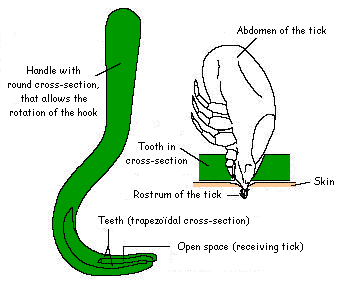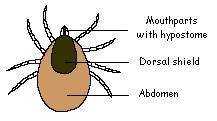Tick
Twister, cont. . .
Shape: The handle ends with
an elongated round head, that the user holds easily between the thumb
and index finger. The shape of the handle is such that the head of the
handle is on the axis of rotation of the instrument regardless of the
degree of engagement of the tick between the teeth. The fork-shaped
lower part has two teeth of trapezoïdal cross-section, enclosing a
V-shaped open space that allows adaptation to all sizes of ticks. The
small hook has an open space of 0,1 to 0,15 mm wide, (0,40 mm for the
big hook) that allows the holding of even the smallest ticks. The fork
of the hook is 7 mm long (15 mm for the big hook): this allows use of
the small hook in cramped conditions, without restricting the rotation.
 Working
principle: The O'TOM hook works with the two following principles:
Tick's prehension without compressing the tick's body ; Tick's
extraction by rotation and not by pulling. Working
principle: The O'TOM hook works with the two following principles:
Tick's prehension without compressing the tick's body ; Tick's
extraction by rotation and not by pulling.
Tick's prehension WITHOUT COMPRESSING the tick's body When a tick
is fixed in the host, it injects saliva in the skin, which contains : .
allergenic matters, which cause odema (swelling) and erythema (redness)
on the bite's point, and pruritus (itching). . often infectious agents
which are transmitted from the tick to people or animals. When the tick
is grabbed with tweezers or similar instruments, the tool exerts a
pressure on the tick's body: this pressure promotes saliva back-flow in
the host skin, and increases the risk of injection of allergenic matters
and above all the risk of transmission of tick-borne microorganisms.
When the tick is grasped with the O'TOM hook, there is no pressure on
the tick's body, thus, reducing the risk of the injection of allergenic
matters and the transmission of microorganisms.
Caution: though tick removal with the O'TOM hooks minimizes
risks, it doen't guarantee that the person or animal is not contaminated
by tick-borne microorganisms. This contamination may have occured before
the removal.
Notice: more and more studies have proved that if you use
chemical products to "put to sleep" or kill the tick (with
ether or oil for example) it is an attack for the tick: it reacts by a
saliva back-flow in the skin, which increases inflammatory phenomena.
With the O'TOM hooks, no chemical substance is used. Tick's extraction
by ROTATION and not by pulling The mouth-parts of a tick include an
hypostome (rostrum) which is implanted in the skin during biting. This
hypostome is fully covered with backward directed projections; this
allows the tick to "anchor" in the skin.
 |
 |
Tick's
mouth-parts under
a microscope |
Tick
rostrum under
electron microscope |
If you pull upon the tick, the spikes will rise and the mouth-parts
of the tick will break and stay in the skin, causing pain and infection.
When you use the O'TOM hooks, you TURN the body of the tick; the spikes
fold into the axis of rotation, and the tick is easily removed, without
traction effort, and decreasing the risks of breaking the rostrum.
The O'TOM® hooks (also marketed in USA under the trademark "TICK-TWISTER®"
) allow tick removal from the skin of animals and people. They are
always sold in a two pack (the large hook for the medium and large
ticks, the small hook for small and very small ticks) , and are
currently the most efficient tools to remove all ticks, any size and
location: without leaving the mouth-parts of the tick planted in the
skin; without compressing the abdomen of the ticks, minimizing the
transfer agents (Lyme's disease, babesiosis...); without ether or other
products; in a few seconds, without pain.
Generalities: Ticks are in the order of acari: they have 8
articulated legs, and a non segmented body. They are external parasites,
which suck the blood of vertebrated animals (especially mammals and
people). They can be found practically in all regions of the world :
throughout the year in warm regions, seasonally in regions with cold
climate.
 Tick's
diagram (dorsal view): There are several species of ticks
(approximately 800); the smallest ticks are less than 1 mm wide, the
biggest can be up to 5 cm wide. In addition, the size is variable,
depending on if the tick is empty or blood-engorged : but note that only
the size of the abdomen changes; legs and shield's size don't vary. The
volume of blood ingested may be from 200 to 600 times their unfed body
weight. Tick's
diagram (dorsal view): There are several species of ticks
(approximately 800); the smallest ticks are less than 1 mm wide, the
biggest can be up to 5 cm wide. In addition, the size is variable,
depending on if the tick is empty or blood-engorged : but note that only
the size of the abdomen changes; legs and shield's size don't vary. The
volume of blood ingested may be from 200 to 600 times their unfed body
weight.
Biology: Ticks live in grass, bushes, undergrowth... They
drop or climb on the host (the host is located with the heat it gives
off). Then they attach (in the thin skined places), inserting their
mouth-parts in the skin. They secrete substances which weaken blood
capillaries; once the capillaries break, the tick sucks the blood
inside. The "blood meal" may last from one to several days.
There are male and female ticks. After mating with the male, female
ticks lay thousands of eggs and then die. From the eggs emerge larvae,
which become nymphs and then adults.
 |
 |
 |
 |
 |
| Engorged
adult female (Ixodes ricinus) It drops from its host to lay |
Laying
female: It lays thousand of eggs |
Eggs
hatching: Each egg becomes a larva |
Larva
under a microscope: (Larvas have only 6 legs) |
Nymph
under a microscope: (Nymphs and adults have 8 legs) |
Female tick needs to be
engorged to lay. Similarly, each life stage may have several phases; the
progression to the next stage needs a "blood meal". Adult male
ticks don't need a host for survival and generally don't eat blood. It
doesn't eat anything.
Tick-borne diseases: It's important to remove ticks fixed
in the skin as soon as possible, because ticks can transmit serious
diseases to animals and people: in people , rickettsiosis, Lyme's
disease, tick-borne encephalitis, tick-fever. For more information about
these diseases, please consult your doctor, or visit specialized sites
(see the sites below). In animals: babesiosis, ehrlichiosis and Lyme's
disease in the dog, babesiosis in the horse, haemobartonellosis in the
cat, babesiosis and ehrlichiosis in the cattle. For more information,
please consult your vetérinarian.
Links: (upon leaving this site, FurryKids.net is no longer
responsible for the content you may see)
Ticks
and Lyme Disease
Institut
Pasteur
Entomology
image gallery of Iowa State University
Lyme Disease
Fondation
Department
of Entomology (University of California)
Department
of Pharmaceutical Sciences (Université de Louvain)
Lyme Disease Action
(UK)
European Union
Concerted Action on Lyme Borreliosis
College
of veterinary Medicine (University of Oklahoma)
Lyme Disease Network
American Lyme Disease
Foundation
<<
Back << |